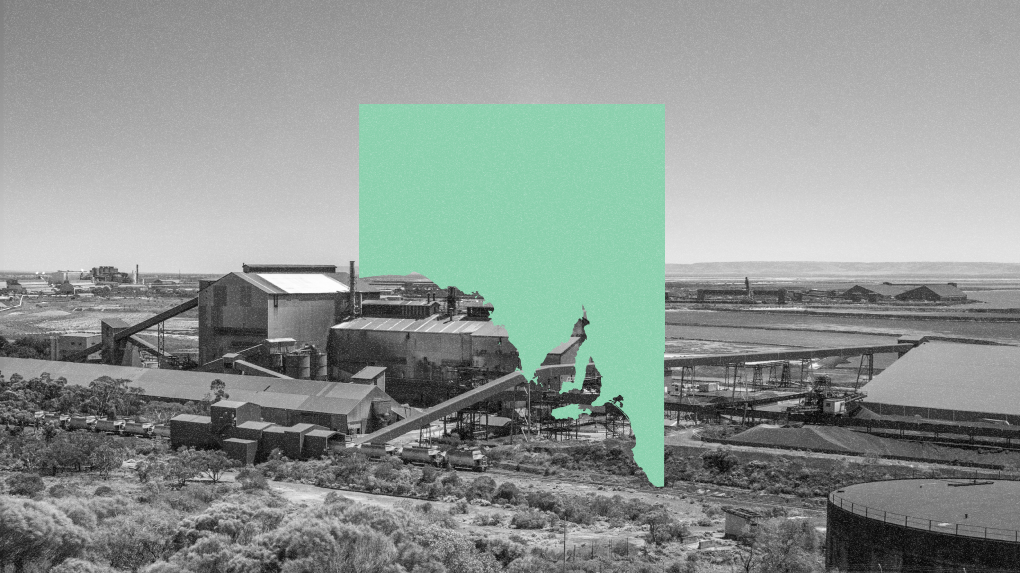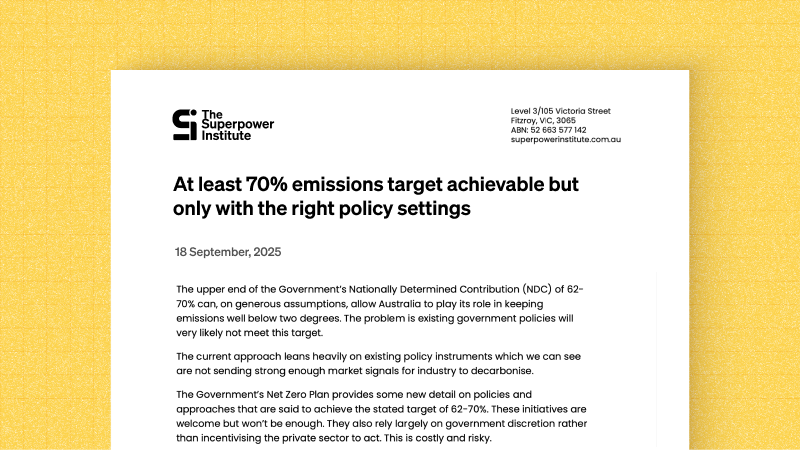Thank you very much for the invitation to speak tonight.
Climate change has often been described as a wicked problem. It certainly is that.
Chris Uhlmann recently wrote an article titled “How young climate change activists are living a lie” (The Australian, June 6, 2025). He said “Has even one of them – that is, the young activists - spent a few minutes marvelling (that we) enjoy a level of wealth that would have dazzled the kings and queens of earlier eras? Do they ever wonder:…could coal, oil and gas have anything to do with it? …Of course not”.
Given my age I am clearly spared this criticism.
There is no doubt that the world could not have developed as it has without fossil fuels.We owe all those involved in these industries a huge vote of thanks.
That does not, however, change the fact that the costs of climate change are becoming even more apparent and that we must reach net zero emissions within a limited and diminishing timeframe.
Those of us deeply concerned about climate change do not need to forgo such pleasures as tonight’s venue and dinner, no doubt facilitated by fossil fuels in so many ways. There is no contradiction between enjoying what we have and to want the world to move away from fossil fuels as fast as possible.
We can have our current lifestyle using net zero technologies if governments take the appropriate steps. And remember, as my colleague Ross Garnaut has said, we did not move from the stone age because we ran out of stones.
Sydney’s once most prominent morning radio announcer had an unintended positive effect on my climate change education. Every morning for quite a while he would say that carbon emissions in our atmosphere only amounted to, I think, 0.00025% so how could they possibly be a problem. OK, I hear that, although I had also heard of trace gasses. But then he said, do you realise that without carbon dioxide there would be no life on earth?
Hang on I thought; if that 0.00025% is vital to our existence this level of emissions cannot be without consequence.
It turns out the without these emissions our planet would be frozen. So what happens when we double this level of emissions to 0.0005 as we are well on track to do? Scary I think.
Anyone who thinks the climate wars are over in Australia is not paying attention. Then we have Mr Trump.
A former Australian Prime Minister thinks that the science behind concerns about climate change is “absolute crap”. Mr Trump and his Energy Secretary agree. I do not see Mr Trump and his Energy Secretary arguing the science, more making assertions.Indeed, their embrace of science seems equal to their embrace of economics.
Tonight, I want to deal with some of the claims made against Australia taking climate action. Having done this I will argue that taking climate action presents a terrific economic opportunity for Australia and that, indeed, the world will find it much harder to meet net zero unless Australia plays its appropriate role.
I will conclude with suggestions for how the Government can take their current actions on climate change further in ways that can set Australia up for success in the net zero world. Such steps are clearly within the Government’s current mandate.
The claims against Australia acting on climate change are many.
The world is not moving to net zero so action is pointless
This is an amazing line. The world has an urgent task to meet a particular goal, but because progress is slow we should stop trying.Really?
In most other endeavours you would urge trying harder. But that is only if you are committed to the goal of net zero in the first place.
You often hear that China is building nuclear and coal fired electricity generation at an amazing rate.But everything China does is huge. What you do not often hear is that in 2024 China installed 429 GW of new electricity generation capacity and that solar and wind provided around 80% of this.
Yes worldwide progress to net zero is extremely disappointing but there are many positive signs. China’s efforts are one. As is the rapid reduction in the cost of solar, wind and batteries. Many countries and industries are taking important steps. As but two of very many examples, we have the EU’s carbon price and now its Carbon Border Adjustment mechanism or CBAM, and the International Maritime Organisation’s mandate for lower emission shipping fuels and a carbon price to drive this.
Further, there now seem technologies able to deal with all the so-called hard to abate sectors.
The issue is not the technology but the economics, and the fierce resistance of the fossil fuel sector and their friends in Parliament and in the business media.
Australia represents only 1% of world emissions so it does not matter what we do
This is flawed thinking on many levels. First there is the moral argument that we must play our part.
More relevant to me tonight, however, is that looking at Australia’s contribution this way, ignoring comparative advantage and trade, is a bit like saying Australia’s role in fossil fuel emissions is minor; only 1.4% of world fossil fuel emissions come from use in Australia. Instead, when exports are added, Australia’s contribution to fossil fuel emissions is more than three times higher. Further, Australia is the largest exporter of coal and gas combined in the world.
The New Energy Trade Report, written by TSI’s Reuben Finighan, fleshing out the thesis of Ross Garnaut in his Superpower books, estimated that Australia can produce energy intensive green exports that could reduce world emissions by up to 10%. Australia should be a green energy superpower because we have an almost endless supply of low cost solar and wind, and only a small population. Look at world heat and wind maps. Our wind and energy resources are terrific, with capacity factors, or availability, better than almost all other countries.
The conclusion that we can produce products that can reduce world emissions by up to 10% is based on two key points.
First, the economics of where energy intensive products are made flips in the net zero world.
As a prominent example of what I am saying here, I have heard some politicians say that we should now be making much more iron and steel in Australia. After all, we have the iron ore, the coking coal needed to reduce the iron ore into iron metal, and the thermal coal or gas to provide the energy. Why export all this only to see iron and steel made in northeast Asia?
The answer is straightforward. Iron ore, coal and gas are inexpensive to export, so the location of them is not that important, and northeast Asia can provide a scale and so cost of production we cannot match.
In the net zero world, however, as I have said, the economics flip. Green iron will need renewable energy both as an energy source and to make green hydrogen, the latter usually needed to take the place of coking coal to reduce iron ore to iron metal. But renewable energy and hydrogen are very expensive to export. Whereas coking coal adds only around 10% to the cost when exported, hydrogen adds at least 100%.
All studies I have seen suggest that Australia should be a major producer of green iron. I do not remember seeing analysis that suggests Australia should be a major producer of iron in the fossil fuel world.
Second, after assessing the low cost sources of emission free energy in China, Japan, Korea, India and Germany, and comparing this to the demand they would have for low cost green energy to run their current economies, Reuben shows that these countries all have a shortage. Alternatively, we have a huge surplus relative to our local needs.
Energy trade has always been fundamental for many countries. Where would Japan be industrially if it did not import coal and gas? Likewise, in a net zero economy Japan will need to import more processed goods with the energy intensity embedded in them.
Energy trade has always been fundamental for many countries. Where would Japan be industrially if it did not import coal and gas? Likewise, in a net zero economy Japan will need to import more processed goods with the energy intensity embedded in them.
Australia has a comparative advantage in producing green energy intensive goods.Rather than export the energy as we do in the fossil fuel world, where the costs of exporting these fossil fuels are low, we should be exporting products with the energy intensity embedded in them. Thus, the New Energy Trade, the title of Reuben’s wonderful work.
Australia should be a significant exporter of green iron, aluminium, polysilicon, urea and transport fuels. These can amount to producing goods that can reduce world emissions by up to 10%.
To reduce emissions why not use nuclear energy or carbon capture and storage (CCS). Why rely on weather dependant solar and wind?
The issue is cost. Firmed renewables are much cheaper than nuclear and CCS.
Whatever past views have been formed, over recent years nuclear costs have steadily risen, but wind and solar costs have plummeted. Of all the nuclear plants built since 2000 in like countries, such as the USA, the UK and France, projects have been much delayed and costs have around tripled those first estimated. Nuclear energy costs are now 3-5 times that of firmed renewable energy.
While Korea and China are reported exceptions to this their nuclear energy costs are opaque and heavily subsidised.
Firmed renewables are not, by definition, weather dependant. Often there is pumped hydro, battery prices are falling, and open cycle gas generation is perfect for firming with low capital costs and high running costs. Even with fossil fuel-based electricity generation gas and hydro are needed to meet the peaks in demand that constantly running coal first plants struggle to meet.
If Australia does not have enough gas currently to firm renewables that is the fault of poor gas policy, not renewables.
But, unlike households, for many of the energy intensive export industries firmed power is not needed. Then the cost equation is even more in favour of renewables.
In many countries nuclear will play an important role in their energy mix. On currently known technologies, electricity embedded in energy intensive products that are tradeable will be met largely by solar and wind, with batteries and other firming where needed. But countries also need non tradeable electricity, which is that used to power households and their local industry. Once their low cost renewables are at capacity further energy in many countries will need to come from higher cost sources such as nuclear and even expensive imported hydrogen. This will not be an issue for Australia.
CCS is very costly except where it is used to enhance oil recovery. New build CCS is currently uncompetitive.
I will leave the final word on this to The Economist Magazine. “Solar cells will in all likelihood be the biggest single source of electrical power on the planet by the mid 2030s….On current trends, the all-in cost of the electricity they produce promises to be less than half as the cheapest available today.” (June 22, 2024)
Green products are uncompetitive, and subsidies are bad policy
I hear people say that the problem with making green products is that they cost more. As if that is the end of the argument. Well of course they cost more to produce if you ignore the economics of climate change.
We would not have a problem in making the energy transition if green products were cheaper than those produced by fossil fuels. The transition would happily be taking care of itself.But for the moment, until scale is built and the technologies mature, they are more expensive than products made with fossil fuels.This should be no surprise.
The key point is that virtually all governments around the world have said that fossil fuels are doing serious harm to our environment and may soon irreparably damage our planet.
Use of fossil fuels are, in economic terms therefore, accompanied by a negative externality. Not addressing this is a market failure; markets will not work as they should. This is the most basic economics.
We cannot move away from fossil fuels, therefore, unless governments ban the use of fossil fuels or put a price on the cost to our environment of their use, that is on this negative externality. The former is unlikely so if governments are serious about reducing carbon emissions they must put a price on carbon. Indeed, this is the way a market economy works. Price the obvious externality and let the market lead the outcome.
Not to do this, and then to complain that green products are too expensive, is illogical. If fossil fuels are paying a carbon price to cover the damage they do to our environment then green products will often be cheaper. Alternatively put, green products will be commercial if they compete on a level playing field.
TSI’s recently released report, A Green Iron Plan for Australia, with Ingrid Burfurd as the lead author in a collaborative effort, provides analysis of the economics of green iron production in Australia. Using detailed modelling it concludes that green iron production in Australia in the most appropriate locations can compete with fossil fuel produced iron when applying the European carbon price to fossil fuel production.
While it would be optimal for Australia to have a carbon price domestically to make our domestic move to net zero a much more efficient one, for Australia to play its role as an exporter of energy intensive products we need a world carbon price, not an Australian one, and we do not have this.
There is little the Australian Government can do about the lack of a world carbon price but it can, and should, compensate for the lack of one. This involves payments to producers of energy intensive exports equal to the increase in costs for fossil fuel competitors if there were a world carbon price.
Yes this is a subsidy, but one justified by basic economics to let products compete on a level playing field. Such a subsidy can only be criticised if you do not think the use of fossil fuels is damaging our environment.
The Green Iron Plan for Australia makes a number of recommendations to address various market failures, as follows.
- The need for the Government to at least initially compensate for the current lack of a world price on carbon to get Australia on the green iron ladder of opportunity.
- Provide up-front grants of 15-30% of the capital cost of the green iron production facility, depending on the technology, to allow for the painful lessons that will be learnt by a few early movers which will be a cost to the first movers but advantage later players.
- Government should have a role in providing common user infrastructure which will be under provided if left to the market where players will provide for their own use rather than for others who will follow.
Other steps are needed of course, such as greatly reducing the time for project approvals or rejections, which currently makes Australia an unattractive place to invest.Australia as a nation has become too complacent.
Given all the projects that have been cancelled green hydrogen is clearly a pipedream
It is worth a brief word on hydrogen because it is much maligned by people who misunderstand its role.
The Australian newspaper’s main story on its front page on June 9 saw the headline “Wake-up call on green energy a hydrogen bombshell”.The article went on to say “The initial cost of producing green hydrogen from Australia’s two largest projects will be four times the price of rival energy sources”.
But the best use of hydrogen will not be as an energy source; indeed, you need energy to make it, and it is difficult and costly to export. It may well be exported in future, as I have just mentioned, as countries move to net zero and run out of low cost low emission energy sources so that they need to import hydrogen for their non tradeable energy needs, as an alternative to nuclear, but it will be costly.
Hydrogen is currently needed in Australia not as an energy source but for its chemical properties as an input to make green transport fuel, green iron and other green products. It is a vital input of production, and so demand for it will depend on demand for production of the final product. Until the Australian Government puts the policies in place to make, say, green iron and green transport fuels in Australia, there will be little demand for hydrogen
Moving to net zero is a wonderful opportunity for Australia
Just as our gas and minerals have played a huge role in Australia’s economic development, for which we should all be grateful, so exporting green energy intensive goods can underpin our future economy.
Reuben Finighan in The New Energy Trade estimates that the potential export revenue from such exports could be about the same size as all of Australia’s current exports of good and services put together. Further, it can be 6-8 times larger than our typical combined coal and LNG export revenues.
Of course, this will take decades to reach and require investing around 5% of GDP per annum over that time. This level of investment, however, is what occurred as Australia took advantage of the Chinese minerals boom 15-20 years ago. High investment levels, yes, but we have done it before.
We will be investing in industries with high productivity growth potential, which can underpin high wages as well as more jobs in regional and remote areas.
Immediate role for Government
I believe there is a clear role for the Australian Government to play. This is to put in place the policies I mentioned earlier. That is, production credits to make up for the lack of a world carbon price, innovation grants of 15-30% of capital costs for the very early projects to compensate for the lessons learned that others will later benefit from, the provision or support for common user infrastructure, and much faster project assessment processes.
Put the policies in place now and see if we can get, say, 5-6 projects to the final investment decision phase in a few years, then in production by 2030, to show we can do this. Show Australians the economic benefits, and show the world that we can produce goods essential to our living standards without fossil fuels.
There is, of course, a cost in all this to our already overstretched budget but it will be reasonably modest and we can reassess the policy framework in, say, 2030. By then more countries may have carbon prices so the need for production credits may reduce or disappear, and/or Australia could have a domestic carbon price which would fund such policies and also solve Australia’s budgetary issues.
What could go wrong?
I can hear some of you thinking that much could go wrong with the above scenario.You are, of course correct.
First, the world might not take climate change seriously, or may not take significant action to address it. But let’s be clear that action is being taken. As I said earlier, the EU has a carbon price and the CBAM. Green products should be price competitive into Europe with products made with fossil fuels. And the International Maritime Organisation is intending to mandate low emission fuels for ocean going ships that carry the world’s imports and exports, and introduce a form of a carbon price to support this. Green shipping fuel projects are emerging around the world and we have a reasonably advanced one in Tasmania.
Many countries have or are introducing mandates on products such as green aviation fuel, and other countries have a low carbon price or are looking to introduce carbon pricing. Mr Trump’s aversion to climate change action is, of course, an issue, but so far it seems few other countries are following this line.
My key response, however, is to ask whether Australia wants all its eggs in the fossil fuel basket. The overwhelming majority of countries have signed up to net zero by 2050, which will dramatically effect our fossil fuel exports, so are we seriously going to bet nothing will happen?
Better surely to at a minimum hedge our bets. Get the 5-6 projects going by 2030 and we have a foot in both camps. The same forces that will see our fossil fuel exports decline will drive the demand for Australia to provide green energy intensive exports.
Further, with the 5-6 projects we can help show Australians and the world what is possible and help influence climate change action.
The second thing you may be thinking is that surely new technologies will come along and make solar and wind irrelevant and so remove our comparative advantage.
There are many responses. The world needs action now as the stock of greenhouse gases in the atmosphere is what matters. You cannot hit net zero in 2050.The trajectory of emissions must start moving sharply down now.
Further, only by making zero emission products now do we provide the scope for the technology to emerge. It is hard to see new technologies occur in a vacuum.
To me all logic says that the Government should provide the policies to see 5-6 green energy intensive projects underway over the next few years.
A final word
As I have said what we need to be successful in the above strategy is a world carbon price. An Australian carbon price cannot help exports.
What an Australian carbon price can do, however, is fund the above policies, fund tax reform, reduce the budget deficit and replace those emission reduction policies we currently have in Australia which are inefficient.
If you want to boost productivity, and provide Australia with a fiscal cushion in these troubled times, it is a no brainer.
Thanks for your attention this evening.
Rod Sims
Chair, The Superpower Institute
Rod Sims is Enterprise Professor at the Melbourne Institute of Applied Economic and Social Research, Faculty of Business and Economics, University of Melbourne, and Chair of The Superpower Institute. He previously chaired the ACCC (2011-2022), served as Deputy Secretary (Economic) in the Department of Prime Minister and Cabinet, and Principal Economic Adviser to PM Bob Hawke (1988-1990).



